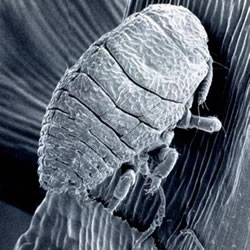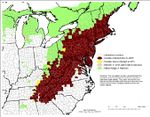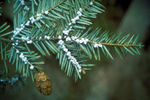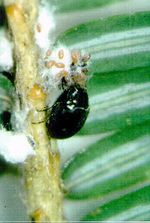Hemlock woolly adelgid
| Hemlock woolly adelgid |
|---|

|
| Scientific Classification |
| Scientific Name |
|
Adelges tsugae |
The hemlock woolly adelgid which is known as the Adelges tsugae an insect that harms all hemlocks in the eastern part of The United States. Hemlock woolly adelgid's are known for the white woolly masses that protect their egg masses during development. They are native to Japan and China, and have become an invasive species in the northeastern US and Canada where they have caused significant damage to Hemlock trees.[1]
Life Cycle
The hemlock woolly adelgid has a complex life cycle, involving two different tree host species as well as asexual and sexual life stages. They are usually concealed under the white woolly masses of wax they secrete from special glands on their back-side. The eggs are brownish-orange and very small. [2] Hemlock woolly adelgids are all female in northeastern North America. They develop asexually and have six stages of development which are the egg, four nymphal instars, and the adult stage. There are two overlapping generations per year. The overwintering generation is present from early summer through mid spring, and the spring generation is present from early spring through mid summer.Overwintering adult females are black, oval, and soft-bodied. [3] The Hemlock Woolly Adelgid reaches maturity between late winter and early spring. Hemlock Woolly Adelgids are covered with wax that resembles the tips of cotton swabs. This wax often remains firmly attached to hemlock branches long after the insect dies. [4]
Ecology
The Hemlock Wooly Adelgid is an insect that is native to Japan. They have become an invasive pest that attacks and kills a plant called "Eastern Hemlock" or "Tsuga Canadensis" which is a tree local to eastern North America. However, the Adelgid doesn't only attack one plant; there is another that they attack which is called the "Carolina Hemlock."[5]
The Hemlock Woolly Adelgid is scattered by wind, birds, forest-dwelling mammals, and humans. Even though they are passively dispersed by that kind of thing, it is spreading at an disconcerting rate and is sufficiently cold hardly to intimidate the existence of the two Eastern Hemlock species throughout their natural distance. [6]
Invasive Species
Location and Method of Introduction The hemlock woolly adelgid is native to East Asia (China and Japan) and has been native since the 1700's. Most of the hemlock woolly adelgids transferred over during the environmental changes Asia had over the mid 1800's and started growing in the east coast of The United States. A lot of the adelgids today attack the east of Canada and have physically destroyed almost all hemlocks in the area of Quebec and Toronto. Today, most hemlock woolly adelgids are established from Georgia to Maine and as far west as eastern Kentucky and Tennessee.[7]
Environmental Impact The hemlock woolly adelgid has had a lot of impact over a lot of other hemlocks located in the east coast of The United States. Even though attacks from the insects happen during the spring and summer, they still do a lot of damage to the defenseless trees without protection. The sole reason why the adelgid is attacking these trees is for food. Today, there aren't as much hemlocks suffering from the insects but back in the early 1990's there were many trees in danger and the infestation didn't stop until a decade later where plants and insects developed into predators and started eating the adelgids that where attacking the hemlocks across the eastern part of The United States.[8]
Control Methods
Hemlock Woolly Adelgid organizations advocate for the mixed use of different procedure including chemical control, biological control, cultural treatments, host resistance, and host gene conversation. The Hemlock Woolly Adelgid is a very baneful infection to the eastern and carolina hemlock trees. Once Hemlock Woolly Adelgid is appearing on an area, you should start to think about their control methods. Handling should begin once Adelgids have occupied the tree. The Hemlock Woolly Adelgid can be treated systemically by using insect powder that is transported in the sap or it can also be treated with foliar sprays. There is also a three soil treatment and two foliar treatment for the Hemlock Woolly Adelgid. The three kind of soil treatment are soil drenching, soil injection, and tablet placement. The two foliar treatment are trunk spray and stem injections. These two kinds of treatments are really helpful for the Hemlock Woolly Adelgid. [9]
Despite large control efforts, huge area in the east part of America, but also especially in Southern Appalachian area, have experienced great hemlock mortality. A lot of the short-term impacts of Hemlock Woolly Adelgid convince on ecosystem structure and function are limited and small. Therefore, long-term impacts like large pulses of woody debris and modify in species form that impact composition and function could be important. [10]
Video
How to protect your hemlocks from the woolly adelgid
References
- ↑ Ellison, A. M., M. S. Bank, B. D. Clinton, E. A. Colburn, K. Elliott, C. R. Ford, D. R. Foster, B. D. Kloeppel, J. D. Knoepp, G. M. Lovett, J. Mohan, D. A. Orwig, N. L. Rodenhouse, W. V. Sobczak, K. A. Stinson, J. K. Stone, C. M. Swan, J. Thompson, B. V. Holle, and J. R. Webster. 2005. Loss of foundation species: consequences for the structure and dynamics of forested ecosystems. Frontiers in Ecology and the Environment 3:479-486. http://www.nyis.info/index.php?action=invasive_detail&id=24
- ↑ Hemlock Woolly Adelgid (Adelges tsugae) new york invasive species imformationCopyright © Cornell University 11.17.2016 unknown author
- ↑ Hemlock Woolly Adelgid Life Cycle in North America maine.gov : department of agriculture, conservationn and forestry. Hemlock Woolly Adelgid Life Cycle in North America. 11.17.2016 unknown author
- ↑ The Hemlock Woolly Adelgid: Life Cycle, Monitoring, and Pest Management in New Jersey rutgers new jersey agricultural experiment station 11.17.2016 unknown author
- ↑ Vose, James M. Hemlock woolly adelgid in the southern Appalachians: Control strategies, ecological impacts, and potential management responses Southern Research Station. Last accessed October 30, 2016.
- ↑ Mark S. McClure, Carole A.S.-J. Cheah. Reshaping the Ecology of Invading Populations of Hemlock Woolly Adelgid, Adelges tsugae (Homoptera: Adelgidae), in Eastern North America Northern Research Station. Last accessed November 5, 2016.
- ↑ Scott Costa and Bradley Onken, FHTET-2006-16, October 2006 http://na.fs.fed.us/fhp/hwa/
- ↑ Author Unknown [1] Effects of Invasive Hemlock Woolly Adelgid on Northeastern Forests Last Accessed November 7, 2016
- ↑ Scott Griffin. Hemlock Woolly Adelgid: Control Options Research Station. Last accessed November 7, 2016.
- ↑ Vose, James M. Hemlock woolly adelgid in the southern Appalachians: Control strategies, ecological impacts, and potential management responses Southern Research Station. Last accessed October 30, 2016.




